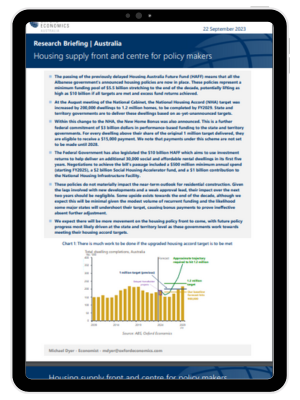Housing supply front and centre for policy makers in Australia

The passing of the previously delayed Housing Australia Future Fund (HAFF) means that all the Albanese government’s announced housing policies are now in place. These policies represent a minimum funding pool of $5.5 billion stretching to the end of the decade, potentially lifting as high as $10 billion if all targets are met and excess fund returns achieved.
At the August meeting of the National Cabinet, the National Housing Accord (NHA) target was increased by 200,000 dwellings to 1.2 million homes, to be completed by FY2029. State and territory governments are to deliver these dwellings based on as yet-unannounced targets.
Within this change to the NHA, the New Home Bonus was also announced. This is a further federal commitment of $3 billion dollars in performance-based funding to the state and territory governments. For every dwelling above their share of the original 1 million target delivered, they are eligible to receive a $15,000 payment. We note that payments under this scheme are not set to be made until 2028.
Tags:
Related posts

Post
The socio-economic impact of TikTok in Australia
This report provides the results of our economic modelling of TikTok’s economic contribution to the Australian economy, as well as the findings of survey research into TikTok’s users and Australian businesses. It looks at the real world impacts users report as well as the diversity of TikTok’s online communities.
Find Out More
Post
Australian office sustainability outcomes underpin asset performance
The focus on green office buildings and sustainability is being driven by both government targets to achieve net zero and increasing corporate and investor focus on environmental, social, and corporate governance (ESG) considerations and compliance.
Find Out More
Post
2024 Insights: Australian Construction & Infrastructure
Calendar 2024 marks a turning point in the construction and infrastructure industry in Australia. While construction activity is expected to fall slightly in aggregate terms, there is also a shift in infrastructure priorities from transport to utilities, social building and resources infrastructure which will present regional challenges.
Find Out More